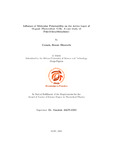| dc.contributor.author | Cornah, Bennie Elizabeth | |
| dc.date.accessioned | 2015-08-05T14:15:37Z | |
| dc.date.available | 2015-08-05T14:15:37Z | |
| dc.date.issued | 2013-05-23 | |
| dc.identifier.uri | http://repository.aust.edu.ng/xmlui/handle/123456789/270 | |
| dc.identifier.uri | http://library.aust.edu.ng:8080/xmlui/handle/123456789/270 | |
| dc.description.abstract | The complexity of the microstructure of the active layer in organic photo-voltaics (OPVs) poses a unique challenge in improving the efficiency of OPV devices. Molecular dynamics (MD) simulation provides a direct route to
determining this microstructure. However, for a donor material like poly (3- hexylthiophene), (P 3HT )n , approximations made in all previous force field for MD simulation has been the neglect of explicit polarization. We looked at the morphology of (P 3HT )n using MD simulations at different temperatures where we confirmed the semi-crystalline behaviour of P3HT between temperatures of 300 K and 400 K. In line with this, we developed force fields from ab initio data with and without inclusion of explicit molecular polarizability for dimers of (P 3HT )1 with monomers optimized at the MP2/cc-pvtz level. | en_US |
| dc.language.iso | en | en_US |
| dc.subject | Cornah, Bennie Elizabeth | en_US |
| dc.subject | 2013 | en_US |
| dc.subject | Theoretical Physics | en_US |
| dc.subject | Influence of Molecular Polarizability on the Active Layer of Organic Photovoltaic Cells: A case study of Poly(3-hexylthiophene) | en_US |
| dc.subject | Omololu Akin-Ojo | en_US |
| dc.title | Influence of Molecular Polarizability on the Active Layer of Organic Photovoltaic Cells: A case study of Poly(3-hexylthiophene) | en_US |
| dc.type | Thesis | en_US |

